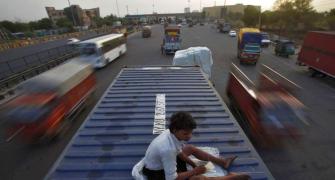Shying away from cutting interest rates further would only extend a "scorched earth" policy of growth sacrifice that India had to follow in 2013 because it had run out of options, notes Andy Mukherjee.
 India's fear of the US Federal Reserve has receded. In its place is a renewed quest to achieve faster growth by cutting interest rates.
India's fear of the US Federal Reserve has receded. In its place is a renewed quest to achieve faster growth by cutting interest rates.
A revolt by foreign investors during the 2013 taper scare forced Indian authorities to sacrifice output in order to preserve financial stability.
Now the squeeze is easing. Two unscheduled rate cuts this year by Reserve Bank of India (RBI) Governor Raghuram Rajan are evidence of the change in strategy.
There are four compelling reasons to believe that the hunt for growth is only going to get busier in the months ahead.
First, the Federal Reserve is sounding more dovish than just a few months ago. The risk that the US central bank will raise interest rates sharply, and lure capital from emerging markets in the process, is waning.
Some developing nations, especially those that rely on selling commodities, could still run into trouble. But if the Narendra Modi government's push to invest in new roads, railways and other infrastructure gathers momentum, India is more likely to face the opposite problem of too much capital wanting to come into the country.
That's the second reason Governor Rajan can be more unambiguously pro-growth: investors are paying attention to India's improving financial health scores.
A once-wide trade deficit has all but disappeared and the rupee has become more competitive against other currencies in inflation-adjusted terms.
Local savers are no longer being punished for keeping their money in the bank. The threat of a mass exodus of savings into unproductive assets like gold is now much lower.
The third reason for resuming the quest for growth is that it could enhance financial stability. The real cost of borrowing in rupees has shot up in the last two years.
Many Indian companies have escaped the squeeze by borrowing in dollars, exposing themselves to the menace of a rising US currency. If money becomes cheaper locally, corporate borrowers will have an incentive to avoid taking such risks.
Finally, the economy requires stimulus. Few believe the recently revised official statistics, which show a miraculous jump in gross domestic product (GDP) growth this financial year to 7.4 per cent, from 5.1 per cent two years ago. By contrast, corporate earnings and sentiment suggest that India is performing below its potential.
The global economy is too weak to offer much help. Consumers and companies in rich countries are skimping on prices they pay to suppliers in developing economies while not demanding extra quantities. Not only does that put a limit on Indian exports, it also shows the danger of allowing local companies to take on more dollar-denominated debt. They may not be able to earn enough hard-currency revenue to repay their obligations.
Finance Minister Arun Jaitley can support growth by investing in infrastructure. But he has already delayed a planned reduction in the Union Budget deficit by one year, and cannot postpone fiscal correction indefinitely.
Regional governments could step up their own expenditure. They will now get a bigger share of tax resources, plus a large bounty from the ongoing auction of coal mines to power and metal producers. Even then, however, a pro-growth fiscal policy would take time to unfold.
By contrast, Dr Rajan has the room to manoeuvre now. Inflation is subdued, thanks to cheap global oil prices and a government-engineered squeeze in rural wages.
It's true that unseasonal rainfall has raised the prospect of crop damage, potentially pushing up the inflation rate of 5.4 per cent. But managing food prices is primarily the responsibility of the government, which has a dominant role across the subsidy-ridden supply chain.
Apart from slaying inflation that arises from supply shortages, there is much else that the government can do to reduce the country's high cost of capital. For instance, India has finally managed to pass legislation that would give foreign insurance companies a bigger stake in their local joint ventures.
Letting the insurance industry expand by tapping global capital is a long-delayed reform. The recent Union Budget has also promised to allow low-wage workers to opt out of the inefficient state-backed provident fund and take their savings to private pension providers.
The small pool of long-term financial savings will eventually grow, bringing down the cost of borrowing in the long term.
But Dr Rajan doesn't have the luxury of time. Monetary transmission is excruciatingly slow in India. It takes 32 months for 80 per cent of any change in Indian policy rates to get partially passed on to non-bank borrowers, according to a recent study by International Monetary Fund researchers.
This time, the lag might be even longer. Public sector banks, which dominate lending, would rather hoard the benefits of cheaper interbank borrowing costs, so that they can write down bad debt. It's up to the government to recapitalise state-run banks and then privatise some of them.
 Making borrowing and lending more competitive will take years. But if the RBI doesn't cut policy rates more aggressively now, the economy would get little out of monetary stimulus.
Making borrowing and lending more competitive will take years. But if the RBI doesn't cut policy rates more aggressively now, the economy would get little out of monetary stimulus.
The Indian central bank governor has questioned the desirability of keeping rates in advanced nations too low for too long.
However, Dr Rajan can't make a dovish Fed change its mind, or stop the Bank of Japan from printing yen more furiously. Quantitative easing by the European Central Bank is already underway.
His remit is to do the best he can to insulate India from the risks of global easy money without paying too high an insurance premium.
Shying away from cutting interest rates further would only extend a "scorched earth" policy of growth sacrifice that India had to follow in 2013 because it had run out of options.
Now that financial stability is more assured, a pro-growth strategy has again emerged as the better alternative.
The Fed's interest rate increases, when they do begin, might force India to halt its growth expedition. Right now, though, there is no reason to call it off.
The writer is the Asia economics columnist at Reuters Breakingviews in Singapore. These views are his own.










